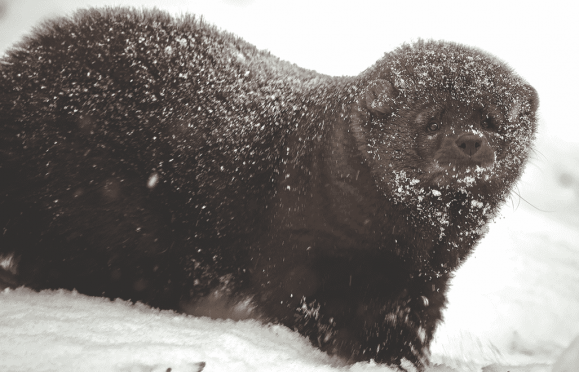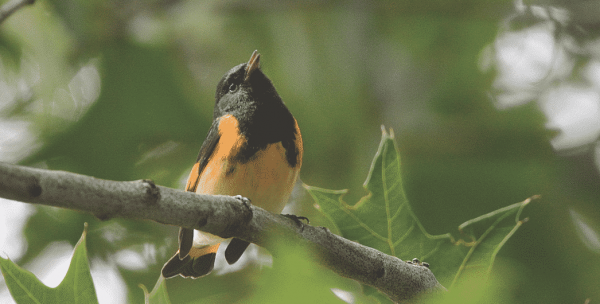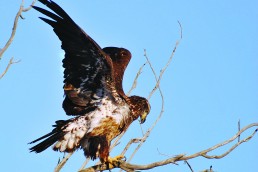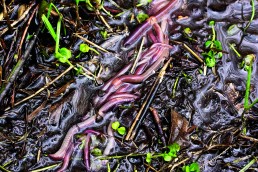Fishers, Walleye Spawn, Redstarts, & More
SHARE THIS POST
Leaving a bad taste in their gills
Compared to other regions in the U.S., the Midwest is home to a modest number of toxic creatures. Some of these inconspicuous critters pack a punch too. A prime example of a poisonous creature in our wetlands and forests are newts, small friendly-looking amphibians. But these produce a toxic secretion to wane off predators. Their toxins are not fatal, but rather deter predators enough by the secretion’s bad taste. Newts have three life stages. First, they are fully aquatic stage as eggs, metamorphizing aquatically into their recognizable newt shape with external gills. They then become “efts” in stage two. This stage is terrestrial, where lose their gills and can be found wandering about forests near water. Researchers have found the eft stage is when toxic secretions are 10 times more potent than the two other stages. Finally, adult stage is where they go back to the water. The adults are fully aquatic, but do not have external gills as they did in the larval stage. While newts may possess a toxin, fear not, for these small amphibians are not out to get you and would rather remain untouched.
The walleye spawn
Understanding a fish’s life cycle allows an angler to appreciate their catch. The spawn is a complex, unique phenomenon for every species. For the prized walleye, their process begins under the cover of darkness as both males and females migrate to shallower portions of a lake or into streams. This migration occurs in late winter and early spring, and eggs are then laid on gravel. The eggs fall into the cracks and crevices. One female can lay as many as 500,000 eggs. These are attempted to be fertilized by many males by letting out milt. If an egg does happen to be fertilized, the parents will never know, as eggs and juveniles receive no parental care. Walleye spawning can last hours or days, which is why afterward they are often exhausted and want nothing more than to rest.
A fungus among us
As hunters, anglers and naturalists, we’re aware of the diseases that affect our favorite species. For example, we have chronic wasting disease in deer, white nose in bats and numbers of different parasites that attack our fish. Our nongame species generally pull the short stick in the amount of publicity their perils receive. Snakes are facing serious threats today. Not only are they troubled with habitat loss, persecution and road mortality, they’re also threatened by a fatal disease known as Snake Fungal Disease (SFD). We see snake fungal taking its worst toll on species that communally den. Timber rattlesnakes have suffered losses because of this disease, as they tend to den in high numbers, and with other species. The fungus causes a snake to be covered in abscesses and lesions, have dry, crusty scales and swollen eyes, appear to be in shed and have a general unhealthy appearance. It’s believed the fungus prevents the snake from being a successful hunter, therefore causing it to starve to death. As of right now it’s too early to judge the impact the fungus has had on populations or make predictions of what it could do. We are seeing it spread, and with new research we are hoping to understand more of the how’s and why’s.
Are you enjoying this post?
You can be among the first to get the latest info on where to go, what to use and how to use it!
Don’t call him a fish
In the Midwest there are a lot of mammals that hardly go noticed. Species living a “fossorial life,” or in such remote places, can make a mammal seem almost nonexistent. One of these mammals was on the brink in Iowa, but is now experiencing a comeback. Recently, the IDNR spotted one on a game in the eastern part of the state.  The fisher hasn’t been seen in Iowa in 150 years, which makes this big news. Iowa is not the standalone state where extirpation has occurred. Fisher pelts were once a high-ticket item, with the excessive harvests causing a large decrease in their population. People spending time in the Upper Midwest and Iowa have the best odds of spying a fisher. Despite having fish in their name, fishers rarely fish and don’t look one and spend most of their time in the forests with the densest cover. The name fisher actually derives from the word “fitch,” meaning European polecat. Polecats are small European mammals that closely resemble the fisher. Fishers reach a maximum weight of 13 pounds, but those under10 are more common. To get an idea of what one looks like, imagine a large, dark-brown ferret that eats porcupines and can climb trees. They sound sort of scary, but fear not, for these woodland critters are hardly a threat and are instead another living gem of the Midwestern biota.
The fisher hasn’t been seen in Iowa in 150 years, which makes this big news. Iowa is not the standalone state where extirpation has occurred. Fisher pelts were once a high-ticket item, with the excessive harvests causing a large decrease in their population. People spending time in the Upper Midwest and Iowa have the best odds of spying a fisher. Despite having fish in their name, fishers rarely fish and don’t look one and spend most of their time in the forests with the densest cover. The name fisher actually derives from the word “fitch,” meaning European polecat. Polecats are small European mammals that closely resemble the fisher. Fishers reach a maximum weight of 13 pounds, but those under10 are more common. To get an idea of what one looks like, imagine a large, dark-brown ferret that eats porcupines and can climb trees. They sound sort of scary, but fear not, for these woodland critters are hardly a threat and are instead another living gem of the Midwestern biota.
Bugging the Midwest
The spread of invasive insects has taken a costly toll on our forests. The effects are most pronounced in the East, but many of those problems have spread into our Midwestern backyards. We’ve seen species such as emerald ash borer have devastating effects on ash tree populations. In recent years, the spread of an insect known as the Hemlock Woolly Adelgid (HWA) has caused great concern. HWA is a small insect from East Asia that was brought over in the early 1920s. This invasive can be found on hemlock and spruce trees, two prevalent species in the East. For now, we only see them in the most eastern portions of the Midwest, but if prevention of their spread is not successful we could find them across the entire region. HWA is detrimental to trees because it sucks the sap, a tree’s lifeblood. Because these insects are asexual and can produce two sets of offspring a year, reducing their population is difficult. The HWA’s egg sacs are small, white, circular objects that can be seen on Hemlock branches. As for the moment, the only way we can combat them is by releasing a biological agent native to their homeland. Some states’ forest departments have released the black lady beetle into their forests, as these feed primarily on HWA and a few other Japanese insects. The success of these attempts will decide how far west they migrate.
Where do you winter?
This region is full of beauty, both living and inanimate. Every single species of our native flora and fauna is unique, and has an amazing natural history. Look to the skies and you’ll see some amazing species, such as the redstart.  These overwinter in Central America and South America, where they’ll remain until a warm up occurs and then migrate all the way back to the Midwest. A typical male American redstart can be characterized by yellow-orange patches under their wings and on their tail feathers. Besides the bright color splash and a white underside, they’re jet black. Females look identical except that their underside is gray as well as their back, where it would be black on the male. Geographical location and the time of year can greatly affect the colors on a redstart, as it can with many bird species. While not rare, they’re still a true sight to behold for any naturalist.
These overwinter in Central America and South America, where they’ll remain until a warm up occurs and then migrate all the way back to the Midwest. A typical male American redstart can be characterized by yellow-orange patches under their wings and on their tail feathers. Besides the bright color splash and a white underside, they’re jet black. Females look identical except that their underside is gray as well as their back, where it would be black on the male. Geographical location and the time of year can greatly affect the colors on a redstart, as it can with many bird species. While not rare, they’re still a true sight to behold for any naturalist.
MWO
SHARE THIS POST
Did you enjoy this post?
You can be among the first to get the latest info on where to go, what to use and how to use it!
Calvin Vick
MidWest Outdoors’ “Nature Notes” columnist Calvin Vick is an undergraduate studying biology, with an emphasis on herpetology, at the University of Central Arkansas. His primary interests are venomous snakes and salamanders. He spends most of his free time photographing the two.



